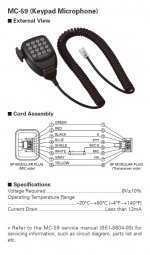- Joined
- Mar 27, 2022
- Messages
- 14
Kenwood Gurus, I'm looking for help with a persistent audio issue. I have an NX-5700/5800 dual deck setup with a KCH-20R advanced head, installed in my truck. I have an annoying, high-amplitude rapid clicking sound in the background of all transmissions made from these decks in NXDN and DMR modes. I first noticed it while testing my audio on a parrot talkgroup in DMR and assumed it was a TDMA artifact, but the same sound is present in simplex NXDN conventional operation as well. I have NX-800 and NX-300 units configured the same (as close as they can be with KPG-111D vs KPG-D1N) in operation and none of them have this issue.
I have tried:
I have tried:
- KMC-65 and KMC-27B microphones.
- Cycling through audio settings such as ANR, microphone profiles, microphone gain, etc.
- Different power sources, including vehicle start battery, vehicle lithium house battery, Jackery power pack, and AC/DC power supply
- Turning over-the-air alias off
- Switching signaling from Fleetsync to MDC1200 and back


